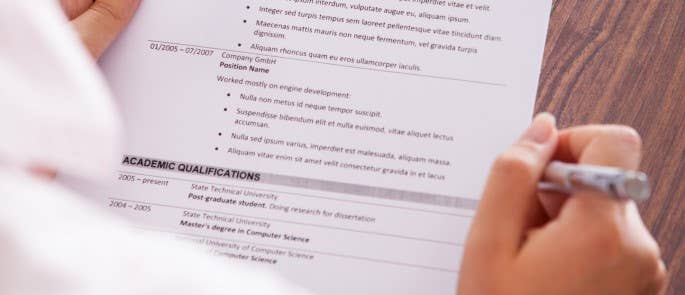How to Write Your First CV: Guidance and Top Tips
Your CV is a powerful job-seeking tool at any point in your career, but as a recent graduate or school-leaver, it is even more vital that your first CV is carefully thought out and crafted.
A CV gives an employer a snapshot of what you have to offer their organisation – your skills, qualities, relevant experience, and interests.
In this article we will introduce some handy tips on what your CV should include, how to structure it, and how to ensure it aligns with the job you are applying for. At the end of the article, you will find a downloadable template to help you get started.
This article contains:
- Why Is a CV Important?
- What Should I Put on My CV?
- How to Write a CV for Your First Job
- CV Ideas and Top Tips
- CV Example for First Time Jobs

Why Is a CV Important?
The term ‘CV’ is short for the Latin curriculum vitae, which translates as ‘course of life’. As your career progresses, your CV will chart the professional course that you take.
Leonardo da Vinci is accredited with writing the first CV in 1482, in order to help convince a rich patron to support him. CVs have changed a bit since then, but the idea behind them is still the same!
They are an opportunity to let a potential employer know why you would be the best person to recruit for the role. Your CV will highlight relevant skills and experiences that you could utilise within the new position.
This is why CVs are so important when applying for a job, and should always be included – even when asked to complete an online application form, there is usually the opportunity to attach your CV as a supporting document, and you should always do this.
What Should I Put on My CV?
With recruitment specialists estimating that recruiters spend on average between five and ten seconds reading a CV, it is important that your CV makes a favourable first impression. It should illustrate that you would be a good candidate for the particular job and hopefully result in you being shortlisted for interview.
A CV should only be one or two sides of A4 paper, so it is important that you only include essential information.

What Personal Information Should I Include?
Using a header function to include your name, address, and contact details (both email address and telephone number) is a good idea as it saves space and makes the details easy for the recruiter to find.
It was once the fashion to include additional personal information such as age, marital status, or even a photograph, but this is not required. It is a waste of precious space, and could potentially lead to discrimination.
Should I Include a Personal Statement on My CV?
Including a personal statement or profile at the start of your CV allows you to quickly introduce yourself.
This should be a few sentences about yourself, summarising the key skills and experience you will bring to the role. It needs to be to the point, whilst giving as much information as possible.
Think of this as an opportunity to market yourself. Make sure you spend some time re-writing it each time you send out your CV to a potential employer. You can reference their company in the statement, again tailoring it to that application. Some examples of personal statements can be found here.
What Skills Should I Include on My CV?
Including a skill section is particularly useful for your first CV, as it allows you to highlight the skills that you have, which may not be linked to employment experience.
By carefully reading the job description and person specification for the vacancy, you will be able to pick out the key skills that the employers are looking for.
Effective coaching and mentoring can help to boost your communication skills as you focus on three key areas: foundations, principles and practice. Learn how to coach or mentor with consistency here.

Examples of general skills that could be highlighted and commented on include:
- Leadership skills.
- Problem-solving skills.
- Communication skills.
- Organisational skills.
- Interpersonal skills.
- IT skills.
- Collaborative skills.
It is good advice to stick to four or five skills to highlight. This can be in the form of a simple bullet-pointed list. Write a short sentence for each, demonstrating evidence of those skills. For example, ‘I have extensive IT skills, further developed through the creation and management of my own website.’
Remember, your pastimes or volunteering activities will evidence certain skills. These are transferable skills and, although they are not linked to a previous job, they could be useful in the vacant position.
Think carefully about your transferable skills. Being part of an organised sports team may have allowed you to develop collaborative skills, time-keeping skills, or resilience. Alternatively, if you create YouTube videos in your spare time, that could illustrate communication skills, IT skills, or confidence with public speaking.
Considering transferable skills is also important if you are writing a CV after a career break. Think about what you have been doing since your last job and which skills you have acquired and regularly practised. If, for example, you have been caring for children during this time, there are a whole host of skills you will have utilised, and these can be included on your CV.

What Education and Training Details Should I Include on My CV?
You should include a section detailing any qualifications that you have gained, arranged in reverse order with the latest first.
List the school, college, or university that you attended, the type of qualification, and the grade that you received. If you are still awaiting final results, you could mark it ‘grade pending’ or include predicted grades, if applicable.
If you are a recent graduate, you might add any particularly relevant academic modules that you have completed.
In this section you should also include any other courses you have taken. If you are applying for a job in a competitive market, proactively gaining some industry-relevant training can show initiative and dedication.
For example, if you are looking for a job in a nursery, you might consider completing a Paediatric First Aid Course.
Interested in Paediatric First Aid?
Find out more about Paediatric First Aid. Take a look at our course library to browse the full list of available courses.

What Work Experience Should I Include on My CV?
The work experience section usually includes your employment history, in reverse order. For each entry you should include:
- The name of the company you worked for.
- Your job title.
- The dates you worked there.
- A brief list of the duties you performed.
When describing your duties, make sure you include key words from the job description, and use strong verbs. For example, if you had a job waiting tables, you might include, ‘Ensuring consistently high levels of customer service in a busy restaurant’.
If you’re applying for a first-time job, it is likely this section will be quite short, but you should include any examples of paid weekend or holiday work, work experience, or volunteering.

What Hobbies and Interests Should I Include on My CV?
A section on hobbies and interests should be included if they are relevant to the job and enhance your application.
Remember you are looking for activities that back up your skills. These could include:
- Sports.
- Blogging or vlogging.
- Volunteering.
- Travelling.
- Art.
- Music.
- Drama.
- Gaming.
You should avoid generic terms that don’t really tell the employer anything about you. ‘Socialising with friends’ is too vague, whereas ‘successfully completing escape rooms’ might indicate qualities such as problem-solving, teamwork, and determination (as well as giving employers a valuable insight into your personality).
Do I Need To Include References on My CV?
You do not need to add names or details of references to your CV, but may want to include a line such as ‘references are available on request’, to show that you would be willing to provide names if required.

How to Write a CV for Your First Job
Now that you are familiar with the key sections within a CV, you need to think about how to best structure them.
There are a few different formats of CV, the most traditional being a Chronological CV. For this type, the main focus is the employment history, structured in reverse chronological order.
However, if you are just entering the professional world after school or further education (or indeed if you are returning after a significant career break), then you would benefit from a Functional or Skills-Based CV structure. This puts the emphasis on the skills and qualities you possess, and on your education and training, with less focus on the employment history.
At the end of this article, you will find a template for a Skills-Based CV.
What Is a Creative CV?
You may also hear the term ‘Creative CV’, which refers to a CV that is presented in a more unusual format. This could perhaps be a video, comic strip, or a QR code.
There are certain industries where you might want to take a more creative approach in order to showcase your applicable skills. These include jobs that focus on art, design, visual effects, etc.

There is some debate around if and when to use Creative CVs, as there are both benefits and drawbacks.
For most vacancies, a more traditional CV will best suit the purposes.
CV Ideas and Top Tips
We have come up with several ideas and tips to help make your CV as effective as possible.
Tailor Your CV to the Job
This is the most crucial piece of advice – and something that is often overlooked. A CV is not a ‘one-size-fits-all’ tool for job hunting. For each individual job vacancy that you decide to apply for, you should read the job description and personal specification to see which particular skills and qualities they are looking for.
You should then re-write your CV, shifting its emphasis as needed so that you highlight these skills. Try to reference the company or brand that you are applying to.
Occasionally you may write a generalised CV to upload to a CV bank for employers to access. Still, even when doing this, think about the industry you are targeting and make sure you include key skills and qualities relevant to it.
Applicant Tracking Systems (ATS)
Many companies, especially larger ones, now use an ATS to initially filter the CVs that are sent to them, before the hiring manager views them. These systems work by searching for keywords agreed by the company.
Therefore, it is extremely important that you check your CV to make sure it is tailored to the specific requirements of the vacancy.
Sell Yourself
Everything included on your CV should help to increase your value as a candidate.
Start strong. Remember that your CV may only be read for a few seconds so make your personal statement a strong, positive reflection of yourself. It will make the recruiter want to read on.

CV Style Tips
A CV should look professional and relatively unfussy, so as not to distract from the content.
Following the tips below will help you achieve this:
- Space your information out so that it can be read clearly.
- Use a clear font (such as Arial, Calibri, or Helvetica), in either an 11 or 12pt size.
- Use bolding and italics sparingly and consistently. For example, always bold the job titles.
- Avoid extra unnecessary design elements, colours, boxes, and borders.
- Keep your CV to one or two sides of A4.
- Structure your information so you don’t ‘bury’ anything important – lead with your strongest section.

What Not to Include in a CV
It is important to remember not to include any of the following:
- Lies or misleading information – your CV must be truthful and you must be able to back up any claims made.
- Irrelevant personal information.
- Unprofessional email addresses. For example, ilovebatman@mail.com does not look professional! Set up an alternative, more professional email account if you need to.
- Names and details of references.
Check Your CV
Finally, make sure that you check your CV thoroughly (several times and then one more!). You need to proofread for sense, to pick up any errors, and to check for formatting consistency.
Make sure you check the spelling and grammar, although be mindful that some software may propose Americanised suggestions.
You could ask someone else to check it for you – a fresh pair of eyes always helps.
Example CV for a First Time Job
Click below to download documents to help you get started with your CV.
We hope this article has given you some practical tips and increased your confidence in writing your first CV. By considering your skills, experience, and qualities, and presenting them carefully, you will be able to impress potential employers. Good luck with your job hunting!
Further Resources:
- Paediatric First Aid Course
- Leadership Management Course
- How to Upskill Yourself
- What is E-Learning?
- What Excel Skills are Employers Looking For?
- Hard Skills in the Workplace









